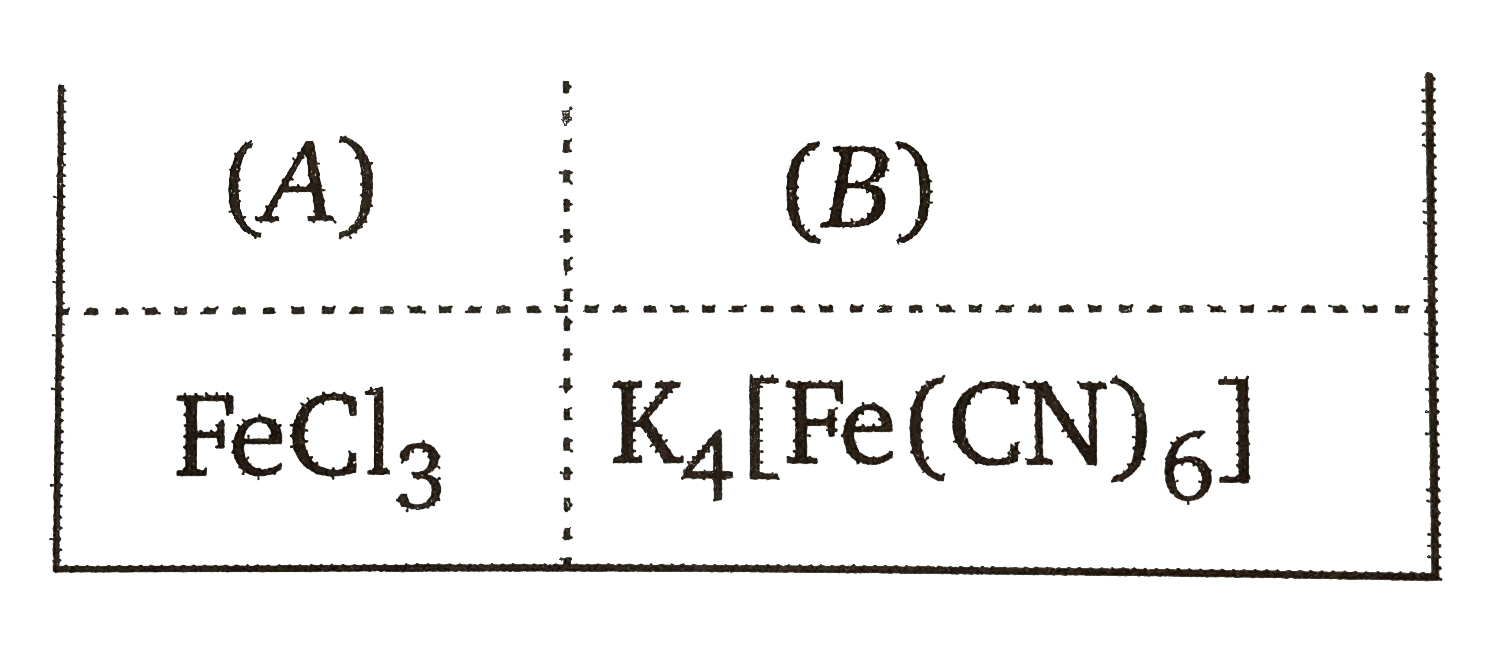Iron forms iron halides salts by reacting the metal directly with halogen. FeI3 does not exist. FeF3 is white soled inspite of five unpaired electrons with d5 configuration . FeCl3 is soluble in water and is used as a mordant in dyeing industry.
Q.FeCl3 solution added to K4[Fe(CN)6] gives A while with KSCN gives B. A and B respectively are:
Fe3[Fe(CN)6]2,Fe(CNS)3
Fe4[Fe(CN)6]2,KFe(CNS)3
Fe4[Fe(CN)6]3,K3[Fe(CNS)6]
Fe4[Fe(CN)6]3,K3[Fe(SCN)6]
The correct Answer is:D
Step by step video, text & image solution for Iron forms iron halides salts by reacting the metal directly with halogen. FeI_(3) does not exist. FeF_(3) is white soled inspite of five unpaired electrons with d^(5) configuration . FeCl_(3) is soluble in water and is used as a mordant in dyeing industry. Q.FeCl_(3) solution added to K_(4)[Fe(CN)_(6)] gives A while with KSCN gives B. A and B respectively are: by Chemistry experts to help you in doubts & scoring excellent marks in Class 12 exams.
Updated on:21/07/2023Topper's Solved these Questions
- d-BLOCK ELEMENTSBOOK - VK JAISWALCHAPTER - d-BLOCK ELEMENTSEXERCISE - ONE OR MORE ANSWER IS/ARE CORRECT
44 Videos
- d-BLOCK ELEMENTSBOOK - VK JAISWALCHAPTER - d-BLOCK ELEMENTSEXERCISE - MATCH THE COLUMN
4 Videos
- d-BLOCK ELEMENTSBOOK - VK JAISWALCHAPTER - d-BLOCK ELEMENTSEXERCISE - Level 1
110 Videos
- CO-ORDINATION COMPOUNDSBOOK - VK JAISWALCHAPTER - CO-ORDINATION COMPOUNDSEXERCISE - ASSERTION-REASON TYPE QUESTIONS
26 Videos
- ENVIRONMENTAL CHEMISTRYBOOK - VK JAISWALCHAPTER - ENVIRONMENTAL CHEMISTRYEXERCISE - ASSERTION-REASON TYPE QUESTIONS
14 Videos
Similar Questions
which of the following is most effective in coagulating ferric hydroxide sol?
a. KCl
b. FeCl3
c. Na2SO4
d. K3[Fe(CN)6]
View SolutionGive the electronic configurations of d-orbitals of K3[Fe(CN)6]andK3[FeF6] and explain why these complexes give different colours with the same solution .
View Solution
Knowledge Check
Iron forms iron halides salts by reacting the metal directly with halogen. FeI3 does not exist. FeF3 is white soled inspite of five unpaired electrons with d5 configuration . FeCl3 is soluble in water and is used as a mordant in dyeing industry.
Q.FeI3 does not exist because:Aof large sizeBFe3+ oxidise I− to I2Cof low lattice energyDiodine is not highly electronegative enough to oxidise Fe to Fe3+Iron forms iron halides salts by reacting the metal directly with halogen. FeI3 does not exist. FeF3 is white soled inspite of five unpaired electrons with d5 configuration . FeCl3 is soluble in water and is used as a mordant in dyeing industry.
Q.FeI3 does not exist because:Aof large sizeBFe3+ oxidise I− to I2Cof low lattice energyDiodine is not highly electronegative enough to oxidise Fe to Fe3+Iron forms iron halides salts by reacting the metal directly with halogen. FeI3 does not exist. FeF3 is white soled inspite of five unpaired electrons with d5 configuration . FeCl3 is soluble in water and is used as a mordant in dyeing industry.
Q.Anhydrous FeCl3 can be prepared by reaction of:AFe with dry chlorineBFe with dil.HCl in the presence of O2CFe(OH)3 with conc. HClDFe2O3 with conc. HCl
Give the electronic configuration of d-orbitals of K3[Fe(CN)6] and K3[FeF6] and explain why these complexes give different colours with same solution.
View SolutionIron forms iron halides salts by reacting the metal directly with halogen. FeI3 does not exist. FeF3 is white soled inspite of five unpaired electrons with d5 configuration . FeCl3 is soluble in water and is used as a mordant in dyeing industry.
Q.Anhydrous FeCl3 can be prepared by reaction of:
View SolutionAddition of K4[Fe(CN)6] solution to FeCl3 solution gives
View SolutionTwo solution (A) containing FeCl3(aq.) and separated by semipermeable membrane sa shown below. If FeCl3 solution on reaction with K4[Fe(CN)6] in aqueous solution gives blue colour of Fe4[Fe(CN)6], the blue colour will be noticed in:

View SolutionInto iron pyrites in water, air was bubbled for a long time. Green crystal (A) and another substance (B) were produced. 'A' in solution was treated with conc. HNO3 and B. The solution was evaporated and crystallized, pale yellow crystals of 'C' was produced .
To the solution of A and C, K3[Fe(CN)6] and K4[Fe(CN)6] were added respectively.
The colors produced are
View Solution
